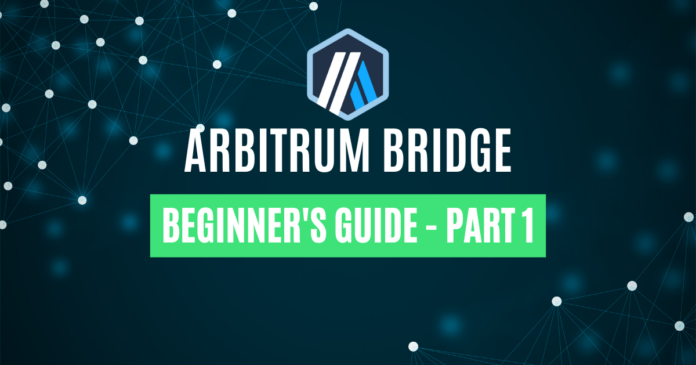Blockchain bridges are revolutionizing the Web3 realm, paving the way for a more collaborative future by connecting disparate chains. This significant breakthrough is a major step toward constructing a fluid, compatible, and productive blockchain ecosystem.
In this article, we’ll explore the dynamic potential of the Arbitrum bridge and how we can seamlessly transfer ERC-20 tokens with it. But first things first.
What Is Arbitrum, And Why Is It The Future Of Blockchain Transactions?
Arbitrum is a layer-2 solution that takes Ethereum’s smart contracts to the next level. This innovative approach utilizes optimistic roll-ups as a scaling technology, enabling Arbitrum to handle transactions on its dedicated sidechain.
Subsequently, it relays the updated chain state to the Ethereum mainnet, combining the benefits of enhanced affordability, accelerated throughput, and the inherent security of Ethereum. As the Ethereum network gains popularity, the increase in congestion and gas prices poses a challenge for users engaging with decentralized applications (DApps) and smart contracts.
🔥 NOTABLE BRIDGES PROJECTS ON ARBITRUM ECOSYSTEM 🔥
Ready to explore the innovative bridge projects on the @arbitrum ecosystem?
Check out our top picks now! #Arbitrum $ARB #Bridges pic.twitter.com/JAKStQpjSF
— Arbitrum Space (💙,🧡) (@Arbitrum_Space) May 17, 2023
Similar to how plants require sunlight to grow, transactions on Ethereum rely on gas to flow smoothly. So, gas fees represent the transaction cost, aligning with the decentralized nature of labor distribution. And just as traditional banks charge fees for wire transfers, miners earn gas fees for facilitating transactions.
While gas fees are crucial for crypto networks, they also serve as a significant barrier to adoption due to their high and occasionally non-scalable nature. It is precisely why Layer 2 (L2) networks exist, with Arbitrum being one of the solutions to this issue. According to Nansen, a blockchain data analytics tool, the average daily fee on Arbitrum was $0.29, compared to $12 for Ethereum.
Source: Nansen
Fancy checking out how much you could save on gas fees? You can visit Arbitrum’s Cost Estimator to compare the fees of your previous transactions. Just paste the transaction hash, and voila! You can see the gas fees required on Arbitrum One versus the ones you paid on Ethereum and discover the amount you could have saved.
What is the Arbitrum Bridge and How Does It Work?
Arbitrum Bridge is a powerful tool designed to establish a connection between Ethereum and Arbitrum. It empowers users to effortlessly transfer their assets between these two chains.
It allows users to move all Ethereum-compatible tokens, such as ERC-20, ERC-721, and ether, from Ethereum to the Arbitrum chain and potentially enjoy faster and cheaper transactions. Offchain Labs, the company behind Arbitrum, has developed two Arbitrum chains running in parallel on the Ethereum blockchain:
- Arbitrum One, the roll-up chain.
- Arbitrum Nova, which uses the AnyTrust protocol.
Using the Arbitrum bridge is relatively straightforward, but users need a wallet to begin bridging. Once initiated, the process should be complete within a few minutes.
Is it Possible to Bridge Different Sidechains and Layer 2 Networks Directly?
After all, most bridges, including the Arbitrum bridge, do not support transfers between various Ethereum Sidechains and Layer 2 networks, creating a situation akin to navigating a city with only one-way streets. For instance, going from Arbitrum to Polygon necessitates passing through Ethereum first. So what should you do? Wanchain’s XFlows is the answer.
Have you tried #Wanchain's #BTC #XFlows yet? 👀
🌉 https://t.co/4kvG4ZnaE2#WeAreAllConnected $BTC $BTC.b $BTCB $wanBTC
— Wanchain (@wanchain_org) May 10, 2023
XFlows enables direct transfers between Arbitrum, Optimism, and Polygon. Unlike other bridges, which are motivated to promote their own Ethereum scalability solutions, Wanchain operates independently from conflicting motivations. Its sole focus is to maximize benefits for users. Now, let’s return to Arbitrum!
The Arbitrum bridge plays a crucial role in Ethereum’s Layer 2 scaling solution, providing users with faster and more cost-effective transactions while upholding the security standards of Ethereum. And with Ethereum facing scalability concerns, solutions like Arbitrum are becoming increasingly vital in facilitating the continuous expansion of the Ethereum ecosystem.
How To Use The Arbitrum Bridge
- Visit the Arbitrum Bridge website.
- Click the “Connect Wallet” button to connect your MetaMask or compatible wallet to the Arbitrum Bridge.
- Select the token you want to transfer from Ethereum to Arbitrum.
- Enter the amount you want to transfer in the token’s native denomination or USD.
- Click on the “Deposit” button and pay the gas fee in Ethereum to initiate the transfer process.
- Wait for the conversion process, which usually takes a few minutes.
- Once the conversion is complete, your token balance will appear on Arbitrum, and you can use it on any dApp that runs on Arbitrum.
- To transfer tokens back to Ethereum, follow the same process in reverse by selecting the coin, entering the amount, and clicking on the “Withdraw” button. The Arbitrum Bridge will convert the token back to its equivalent on Ethereum ($ETH) and deposit it into your Ethereum wallet.
Not sure how to use Arbitrum? 🔵@bluestwind from @ConsenSys has you covered! Check out their tutorial on how to bridge to Arbitrum One! 🌉 https://t.co/FdJfjX7VnL
— Arbitrum (💙,🧡) (@arbitrum) December 13, 2021
How to Bridge Assets from Polygon to Arbitrum with the Arbitrum Bridge
Arbitrum bridge presents an excellent tool for users who wish to transfer their assets between different blockchain networks, including bridging between Polygon and Arbitrum. Here is what you need to do:
- Connect to the Polygon network using your preferred wallet. There are several wallet options available, including Rainbow, Coinbase Wallet, MetaMask, WalletConnect, Trust Wallet, and Ledger Live.
- Visit the Arbitrum bridge portal and connect your Arbitrum wallet.
- Choose the asset you intend to transfer and input the amount.
- Verify the transaction and wait for the Polygon bridge to validate it.
- Upon validation, the assets get locked on the Polygon network, and the user receives an equivalent amount of wrapped tokens on Arbitrum.
Users can access their wrapped tokens using the Arbitrum wallet and utilize them on the Arbitrum network. The bridging process may take some time, depending on network congestion and other factors. Finally, you can use your Arbitrum wallet to access your wrapped tokens and make use of them on the Arbitrum network.
Risks and Benefits of the Arbitrum Bridge
The bridge uses a lock and mint mechanism to transfer assets securely and reliably. Specifically, to transfer assets, the Arbitrum Bridge locks Ethereum assets in a smart contract on the Ethereum network and mints the corresponding asset on the Arbitrum network.
Moreover, the bridge incorporates an optimistic roll-up solution for Ethereum transactions, significantly reducing gas fees and transaction times. Developers have conducted multiple security audits and taken measures to minimize potential risks.
However, users must exercise caution while using the bridge and conduct thorough due diligence before transferring assets. As the development of bridges is still in its early stages, uncertainties remain regarding their performance and security.
Conclusion
While the concept of bridging may appear complex, executing it in practice is surprisingly straightforward. It is essential to carefully follow the instructions and ensure the correct network is selected before initiating the bridging process.
Additionally, it is crucial to bear in mind that utilizing bridges entails certain risks. For example, encountering smart contract bugs or experiencing potential loss of value.
Fortunately, utilizing the Arbitrum bridge is relatively simple. By transferring your Ethereum-based tokens to your preferred Arbitrum chain, you can reduce transaction fees and potentially benefit from improved transaction speeds compared to Ethereum. So, happy bridging!
⬆️ For more cryptocurrency news, check out the Altcoin Buzz YouTube channel.
⬆️ Our popular Altcoin Buzz Access group generates tons of alpha for our subscribers. And for a limited time, it’s Free. Click the link and join the conversation today.




























